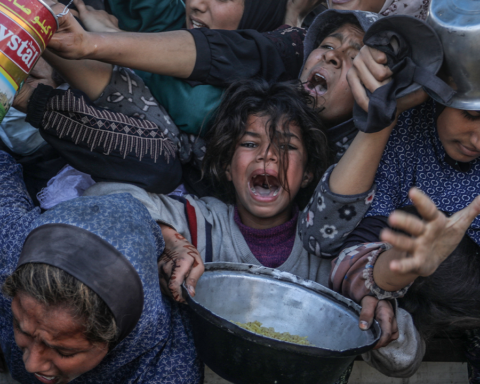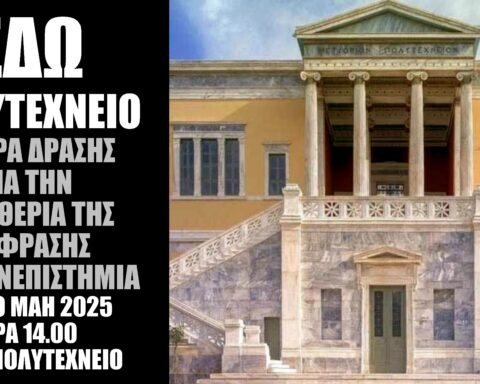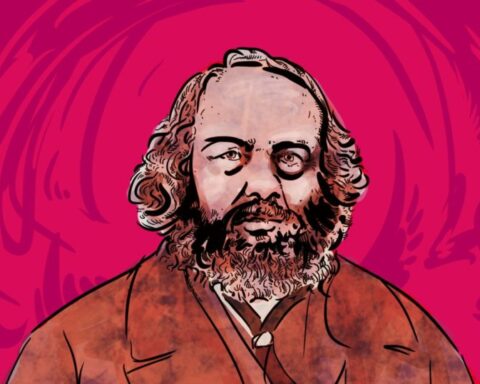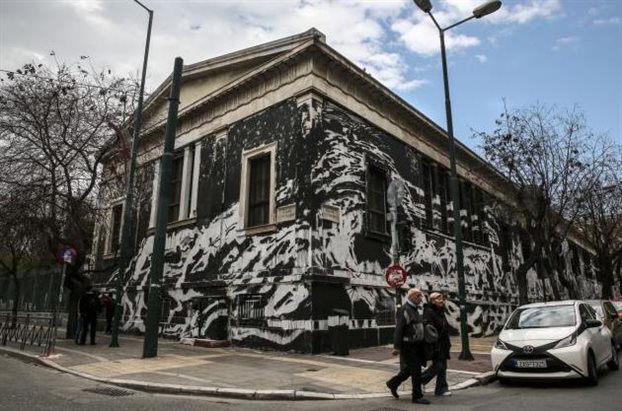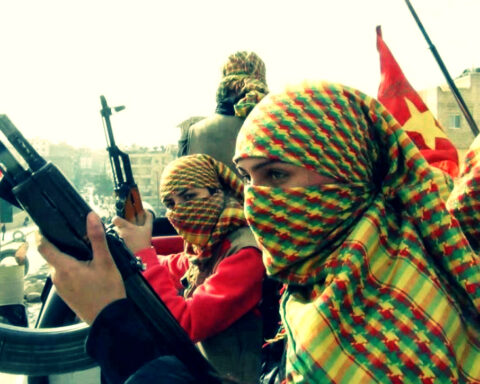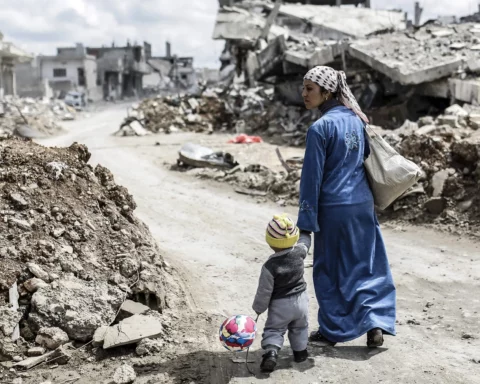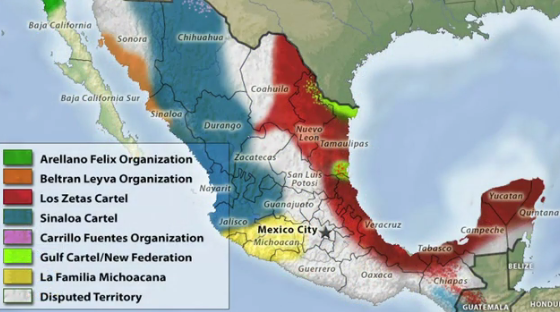
2010 was going to be an exceptional year, to judge by the public relations billboards the government erected along the highways: a modern Mexico was going to celebrate the Bicentennial of its War for Independence and the Centenary of its Revolution at the same time. And it certainly was an exceptional year. Every year, on January 6, the children who gather at the feet of the Angel of Independence, in Mexico City, submit their letters to the Three Wise Men. “Dear Three Wise Men, we do not want Calderón’s war”: this was the message for the year 2011, written on a placard carried by a ten-year-old boy. If Mexico still exists in 2110, 2010 will be remembered as one of the bloodiest years in all of its history. The “drug war” has, to date, caused 34,000 deaths, and almost half of them were accounted for by murders committed in 2010. A large number of these deaths are considered to be “collateral damage”.
Do we really need to relate the shocking statistics? On October 22, 2010, the daily newspaper Reforma counted 9,598 executions in the country since January 1, 2010. But the count grows with each passing hour; on that same day, 14 teenagers were assassinated at a birthday party in Ciudad Juárez, in Chihuahua. On October 24, 13 young people who had just completed a drug rehabilitation program were assassinated at a rehab center in Tijuana, in Baja California. On October 28, a group of gunmen attacked three vans transporting workers from a maquiladora in Ciudad Juárez, killing 5 and wounding 14. On October 30, 15 young people, 11 of whom were enrolled in a drug rehabilitation program, were assassinated at a car wash in Tepic, in Nayarit. In January 2011, the spokesman for the Ministry of National Security acknowledged that there had been 13,593 executions in 2010, which therefore means, if we compare this figure with the figure provided by Reforma, that there were 3,995 executions in the last ten weeks of the year alone….
Even those who are only trying to go to the United States are not exempt from the threat of violence. The Zetas, with the obvious complicity of the police, control the extortion rackets imposed on immigrants and execute those who refuse to pay. In that same month of October 2010, a mass grave was discovered in San Fernando (in Tamaulipas), about a hundred kilometers from the border, in which the bodies of 72 Central American immigrants were found. It must be assumed that this mass grave was intended as a message….
The closer you get to the border, the greater the danger. The border is no longer just a line of demarcation between the first world and the rest of the planet, built of walls and barbed wire fences. The border has become a social relation, one that implies violence—whoever exploits the border by trafficking in human cargo has to control the routes of passage, eliminate the competition and intimidate those who are reluctant to pay. Drugs, just like illegal immigrants, are commodities, and both accrue value by the mere fact of crossing the border. At a certain point, however, the commercial balance between the two sides of the border has a tendency to reach a state of equilibrium: if the Latina drugs cross the border in one direction, yanki guns cross the border in the other direction.
Paranoia, which is inherent to the American nation, has contaminated Mexico, not despite, but because of the border. Over the last few years, various films have accurately illustrated this paranoid essence of the border, such as No Country for Old Men, directed by the Cohen brothers, and The Three Burials of Melquiades Estrada, directed by Tommy Lee Jones. What was new about Calderón’s war, which began four years ago, derives from the fact that the logic of the border is spreading far beyond the fortified line of the frontier, for the purpose of transforming the northern states of Mexico into a security zone for the United States. Such were the directives that Felipe Calderón received from George Bush in 2006. The wider the security zone around the border, however, the greater the profits for the traffickers who cross it (thus, a pollero who earned $600 to conduct an illegal immigrant from Tijuana to Los Angeles fifteen years ago, will earn—now that the border controls have multiplied—no less than $2,000). There is therefore no reason why this hellish circuit should end. And all of this has a social cost: today, as even the most prudent observers from the U.N. will attest, Mexico is now plagued by levels of violence that are comparable to those of Iraq and Afghanistan.
*
The war on drugs will be the enduring achievement of President Felipe Calderón. The candidate of PAN (Partido de Acción Nacional—National Action Party), elected thanks to an avalanche of electoral fraud in 2006, has since then led the country in accordance with this objective. The corruption of the various police forces was used as an argument to deploy the Army throughout the entire country on the pretext of dismantling the drug cartels. It is clear that the police were getting their piece of the action, of this there can be no doubt; in 2009 more than 2,000 police were dismissed from the service and even denounced for collusion with some of the criminal gangs…. But these were only small fry: the “penitents” only confirmed what had been the stuff of rumor, that is, that for years the upper echelons of the police forces had been escorting drug convoys to the United States and guaranteed protection for the big bosses. And did the Army have nothing to do with this? The fact that the drug traffickers possessed weapons and ammunition that came from the military arsenals tends to prove the contrary, as does the fact that, in 1999, several dozen deserters from the Army’s elite corps, the “Grupos Aeromóviles de Fuerzas Especiales” [Special Forces Airborne Units] (GAFES) created one of the most dreaded criminal organizations in the country, the Zetas, a group of assassins originally employed by the Gulf cartel. We should also recall that the GAFES, from which the Zetas arose, were created in 1995 specifically for the purpose of fighting against the Chiapas insurrection, and that they were trained in the United States and Israel. The American military has also made its own contribution, insofar as many Chicanos who were discharged from the U.S. Marines after serving in Iraq or Afghanistan sold their services to one of the Mexican drug cartels….
Currently, one out of every three individuals arrested for participation in drug trafficking in Mexico is, or was formerly, a member of a police unit or a detachment of the Mexican Army—it is more advantageous for the drug cartels to hire people who have already been trained as cops or soldiers rather than having to take the trouble to train them to be assassins…. Furthermore, everyone knows that almost every unit of the State’s intelligence services, whether police or military, sell vital information to the drug cartels so that the latter can identify and eliminate their competitors.
The judiciary is just as corrupt, with its judges who are perfectly capable of fabricating imaginary charges to imprison rebels, but who are curiously incapable of imprisoning certain assassins who have committed dozens of murders. The public prosecutors, who are always ready to throw the book at ordinary people for stealing small sums of money, are equally incapable of detecting the millions of dollars derived from drug trafficking that are openly invested in luxurious mansions, fleets of automobiles, hotels, restaurants, etc.
In any event, the word “corruption” falls far short of the truth when what we are talking about is the active complicity of the services of the State and every one of the three big political parties. At the federal level, it has been a very long time since there was a President who did not have privileged connections with one of the drug cartels. It reached the point where it is said that if no one has managed to arrest “Chapo” Guzmán, a fugitive from justice since 2001, it is because he can count on the favor of the government—which is confirmed by the very small number of members of the Sinaloa drug cartel who have been arrested, compared to the other drug cartels. From the lowest to the highest levels of political power, if someone is elected it is by means of corruption and intimidation, and that costs money. Money which, obviously, cannot be declared on a tax return.
All of this might have been merely a bump in the road in the worst of all possible worlds, where the entire political class receives subsidies from the drug traffickers. The yanki big brother, however, instead of waging the “war on drugs” inside its own borders, prefers to export this war to the other side of the frontier. Its goal is to neutralize a country which has been a powder keg since 1994. The result is that, for four years, all of Mexico, and especially the northern part of the country, has been living in an undeclared state of emergency. Article 29 of the Constitution authorizes the legislature to declare a state of emergency; the Mexican generals, annoyed by the fact that they do not have a precise legal basis for their activities, are in favor of such a legislative initiative. In fact, such a declaration would be nothing but a legal formality, and the government can also afford to delay implementing such a measure. General Guillermo Galván, Secretary of National Defense, declared in January 2011 that the presence of the military on the streets of the country would have to be prolonged for another ten years. The general expressed his regrets that this should be necessary, and suggested that closer collaboration with the United States could abbreviate this period…. He stated that he is ready to accept any proposal in favor of such collaboration. This little bit of blackmail seems to be intended to pave the way for a U.S. military presence on Mexican territory, in accordance with the precepts applied in Colombia, where, since 2009, a dozen American bases have been constructed with the government’s consent, in the name of the war on “drug trafficking and terrorism”, the latter being identified with guerrilla movements. And this is an amalgam upon which Hillary Clinton repeatedly insists when she evokes the specter of a “narco-insurgency” in her visits to the Mexican capital. We should also point out that thousands of soldiers and thousands of Mexican officers are periodically sent to Colombia for military training.
An unprecedented meeting took place in Washington on April 14, 2010: Admiral Michael Mullen, Chairman of the U.S. Joint Chiefs of Staff—and former military commander of the invasion of Afghanistan—met in his office with General Guillermo Galván and Admiral Mariano Francisco Saynez, commander of the Mexican National Navy, along with General Freddy Padilla, the commander-in-chief of the Colombian Armed Forces. The purpose of this meeting was to “strengthen cooperation in the fight against drug trafficking and terrorism”. It was the first trilateral meeting of this kind. On February 12, 2011, Admiral Mullen declared: “In certain respects, this war on drugs and our way of fighting it are very similar to what we have seen in other wars that we have fought.” The use of the first person plural is in itself very significant and, in fact, various persons have recently broached the hypothesis of an “American invasion of Mexico” in the not-too-distant future.
Such an invasion, however, is quite unlikely. First of all, because the presence of American soldiers on Mexican territory would tend to provoke reactions that would be very hard for the Mexican government to control. But above all, such an invasion would be perfectly superfluous. Because the United States has already invaded Mexico.
The invasion began sixteen years ago with the North American Free Trade Agreement (NAFTA), signed by the PRI (Partido Revolucionario Institucional—Institutional Revolutionary Party), which had been in power for decades. By opening up the country to American capital and commodities, however, the PRI cut off the branch upon which it was sitting. With the implementation of NAFTA, the PRI inevitably had to give way to another king of governance, one more in accordance with neoliberal ideology. The victory of the PAN in the 2000 presidential elections marked the passage from one era to another. Vicente Fox, before becoming the President of the Republic in 2000, was the General Director of Coca-Cola for Latin America. The PAN is nothing but the Party of the United States in Mexico. The bulk of its voters come from the comfortable middle classes, who see its ultraliberal orthodoxy and its conservative ideology as the guarantors of their American-style standard of living. The PRI is still popular, however, in a good number of municipalities and regional governments where its consummate command over the old patronage machines assures it of a certain degree of electoral loyalty.
*
Today’s violence does not involve two clearly defined opponents, contrary to the State’s propaganda. Complex, overlapping alliances between drug cartels, parties, and sectors of the State and the Army are made and broken, and a large number of the executions would be inexplicable for those who believe the President’s speeches. The rival drug cartels kill each other’s members; a gang of drug traffickers engage in a shootout with the military, which is for its part protecting a competing gang of drug traffickers; government and police officials are assassinated (because they are incorruptible or because, to the contrary, they are all-too-compromised—who knows?); and, above all, thousands of civilians are victims of both sides. Passers-by struck down in the crossfire by stray bullets, motorists shot for having hesitated to stop at a roadblock, young people riddled with bullets for having attempted to flee from an Army raid, drunks killed for not having understood warnings, chavos [“kids”] in rehab centers killed for having committed the mistake of straying from the path of the deal, etc. Even more unfortunate, the dozens of young children who are killed by bullets, not all of them caught in a crossfire…. Those who fall into the hands of the Federal Police1 and other military forces, especially the Marines, have no chance of escape; they have to buy their way out, which means they are people who have been seized at random and tortured for days, forced to sign false confessions, poor devils imprisoned without the least evidence of guilt….2 In certain cities in northern Mexico, there is no need to declare a curfew; it is obvious to everyone that a curfew is in effect.
Woe to the civilians who are struck down in this dirty war! You do not die because you are guilty, you are guilty because you die. President Calderón, commenting on the assassination of sixteen miners in Ciudad Juárez during a party, declared: “They were probably assassinated by a rival gang.” The families of the victims hung placards on their houses: “Mister President, until the perpetrator is found, you are the murderer.” Occasionally, even the children of the comfortable middle class figure among the victims of this strategy of universal intimidation, like those two students of economics shot in cold blood by soldiers in Monterrey, in Nuevo León, in April 2010. And to think that their parents had certainly voted for Calderón in 2006!
This violence inevitably calls to mind the civil war that began in Algeria in 1992. It is reminiscent of those massacres of entire villages, whose perpetrators and motives are impossible to identify (the jihadists? the army? the people of the neighboring village?). Faced with the tragic meaninglessness of such massacres, most Algerians, already living under the pressure of countless hardships in their day-to-day lives, ended up yielding to disgust and accepting their fate: and this is precisely the real purpose of these massacres. If the purpose of a military action is to be judged solely by its result, this brutal and unexpected eruption of death, it is all the more terrifying because of its indiscriminate nature, and leads as a result to the abandonment of the social body by all rationality, in Algeria just as in Mexico. So no one tries to understand, but just to survive. Fear atomizes the population, destroying the collective capacities of resistance and instilling the poison of generalized mistrust. “Calderón’s war” is working perfectly as a strategy of intimidation on a vast scale.
*
Ciudad Juárez was already world-famous for the 400 women who were murdered there over the last ten years. But this systematic feminicide was, unfortunately, merely the beginning, and this border city had yet to rise in the hit-parade of horror until it reached its current status as the most dangerous city in the world. No fewer than 2,700 people—of whom almost one-half were children—have been murdered in Ciudad Juárez in 2010. “Genocide against young people”, the NGOs claimed, which openly called for United Nations intervention. “We are facing a campaign of murder against young people that must be dealt with by a new strategy. Ciudad Juárez is no longer host to social, public and business activities because of the terror of the population”, declared Nashiely Ramírez on November 25, 2010, a member of Ririki Intervención Social. “Enough of this absurd and disgusting situation! It is more like a war against society than a war against drug trafficking!”, declared Gabriela Meyra, of the Centro de Derechos Humanos Fray Francisco de Vitoria. “We are living in a police-military narco-state”, added Adrián Ramírez, of the Mexican League for the Defense of Human Rights. We note that one of the judges responsible for helping Calderón manage this drug war was the Attorney General of Ciudad Juárez during the period of the feminicides, and that he was distinguished by his lack of activity with regard to these murders.
On October 29, 2010, soldiers opened fire on the “Kaminata contra la muerte” [“Walk against Death”] of the students of Ciudad Juárez, who marched to demand the withdrawal of the Federal Police and the demilitarization of the city. José Orrontia, a well-known member of Otra Campaña, was shot in the back and seriously wounded. In a press release, the Attorney General of the Republic tried to justify this treacherous attack by claiming that some of the demonstrators were wearing masks (their faces were painted or they were wearing ski masks)….
So the Army shoots civilians at the drop of a hat—what could be more normal? What else did it do when it massacred people in Chiapas and in Guerrero, that it has not done for many years? Now it is Chihuahua, where the Army is murdering those who commit the mistake of opening their mouths. Armando Villareal Martha was assassinated, a peasant leader in Chihuahua and organizer of various campaigns to refuse to pay the rates of the Federal Electricity Commission…. And in Ciudad Juárez, they assassinated Manuel Arroyo, a researcher investigating the working conditions in the maquiladoras, as well as Geminis Ochoa, a representative of the street vendors, after both of them received threats from the Federal Police for having called for a march against the abuses of the Army. They assassinated Josefina Reyes, who was harassed by the Army because of her public complaints about the militarization of the Juárez Valley. They assassinated Benjamin LeBaron, who promoted demonstrations against secuestros [kidnappings]. They assassinated Susana Chavez, who tirelessly denounced the feminicide of Ciudad Juárez. Some of them were victims of the drug cartels, but many were executed by the assassins of the Federal Police, the Marines or the Airborne Special Forces. Not to mention the journalists who were assassinated or seized by the cops and beaten to a pulp for having written about the complaints of civilians against the behavior of the soldiers—some even had to go into exile in the United States.
The army is the ultima ratio of the State. Who, apart from the PAN’s most loyal voters, can really trust the Army? In December 2010, the Centro Internacional de los Derechos del Hombre (CIDH) [International Center for Human Rights] issued a declaration denouncing the Mexican State, in relation to the arrest of Rodolfo Montiel and Teodoro Cabrera, who were taken into custody by the Army on May 2, 1999, arrested and tortured for several days. These two peasants were defending the forest of their village, Petatlán (in Guerrero), which had been handed over by the Mexican government to a multinational timber company. They were arrested and sentenced for … drug trafficking. Only with the election of a new President in 2000 were they released for “humanitarian reasons”, in November 2001. This is only one of many recent examples, which joins thousands more of the same kind. But this affair in particular led the CIDH to demand that the Mexican State must reform the Code of Military Justice…. Such a reform, it was assumed, would lead to the arrest and conviction of military personnel guilty of the abuse, torture or killing of innocent civilians; the proposed bill, however, was killed in the Senate under pressure from the military. Soldiers hopped up on cocaine or half-drunk who take pot-shots at random persons therefore have nothing to fear, at least as long as they restrict their pot-shots to civilians (two drunk soldiers conceived of the bad idea of killing a policeman on the subway in Mexico City on January 20….).
*
A virtuous violence, the violence of the State, seeks to put an end to the mafia-style violence of the drug traffickers. But the barbarism of the latter bears the trademark of the former. When one takes into account the large number of former cops and ex-soldiers who have joined the death squads working for the drug cartels, the disgusting atrocities and spectacular sadism of so many of these assassins are less surprising. They are reminiscent of, and indeed almost indistinguishable from, the operations of repression of the era of the “dirty war” of 1960-1980, with the disappearances of the opponents of the regime, massacres of unarmed demonstrators, villages that were entirely wiped out…. And certain macabre innovations, like that of hanging the bodies of the victims from highway bridges or displaying severed heads in the public squares, practically bear their signature: where did they learn to kill and mutilate in this way, in cold blood, except in the counterinsurgency squads and paramilitary units?
Paramilitary violence is undoubtedly the source of all this violence that is currently inundating Mexico. It is the informal environment where professional soldiers who want to make some more money, drug traffickers and PRI scumbags cross paths. With this difference, however: the exactions of the paramilitaries are directed against rebel communities, while Calderón’s war seeks to condition everyone. And where does the money come from for recruiting, arming and training these paramilitary groups that are wreaking havoc in the states of Chiapas, Oaxaca, Guerrero and Michoacán? From the secret funds of the State, without any doubt; and why not from the equally secret funds of the drug traffickers? Is there really any difference between the two?
On August 12, 2009, the Mexican Supreme Court ordered the release of the perpetrators of the Acteal massacre. We will recall that in December 1997 these individuals murdered 45 people, mostly women and children, who lived in the community of Las Abejas, in the village of Acteal, in Chiapas. Due to the fact that it professed non-violence, this community had not joined the Zapatista Army of National Liberation (EZLN), although it sympathized with that movement. The message of the Acteal massacre was very clear: those who do not categorically reject all contact with the EZLN can die the same way. These killings betrayed the influence of the centers of anti-guerrilla training; for example, by the fact that the bodies were disemboweled and dismembered, just as was done in nearby Guatemala during the era of the counterinsurgency war. The release of the direct perpetrators of the massacre—those who gave the orders were never formally identified—at the high point of Calderón’s war constituted a second message.3
It is this type of message that the various protagonists of the “war on drugs” are now sending by dint of massacres. For all these deaths speak; they speak a language, the language of that paranoia that characterizes the exercise of absolute power. The paranoia caused by the drug traffickers is joined by the paranoia caused by the State. By definition, drug trafficking erects suspicion and the obsessive fear of betrayal into a rule of conduct. By definition, the Army considers every civilian to be a suspect. Everyone knows perfectly well that the soldiers of the United States deployed in Iraq were trained to suspect every pedestrian, every passer-by—an old man, a little child might carry a bomb, it is preferable not to take any risks, shoot first. Composed entirely of suspects, the Iraqi population paid the price for this yanki psychosis. It is precisely this paranoia that the American leadership has successfully imposed throughout Mexico by means of the PAN government.
The drug traffickers harbor this same military paranoia towards all civilians. In December 2010, the bodies of 22 Michoaqueños who had disappeared at the end of September in Acapulco were found in a mass grave. They worked for a company that rewarded its workers each year with a short group vacation in Acapulco. They died only because they came from Michoacán. This was revealed by an informant who knew that the Zetas mistook them for men from the Familia who had come to set up operations in the tourist capital of Guerrero….
It is true that up until now the territories were well-defined. The Gulf cartel controlled the east coast, from Guatemala to the Texas border, the Pacific cartels (the Sinaloa cartel, the Juárez cartel, the Familia, etc.) controlled the west coast and the border from Tijuana to Ciudad Juárez. The Zetas, who had broken with the Gulf cartel after the death of its founder, are waging a general offensive with the long-term goal of controlling all the routes to the border. This will not be a walkover: for example, the Sinaloa cartel has claimed responsibility for the deaths of 27 Zetas on a single day in January 2011…. Now there is talk of a “cockroach effect”: the dispersion of the drug organizations and their activities throughout the entire country, which promises to spread the violence everywhere.
*
“Civil society” called for peace in the face of the military intervention in Chiapas after the Zapatista insurrection of January 1994. Then, the big marches in the capital constantly reaffirmed the peaceful nature of the movement of disobedience and resistance. But what we are facing now is war. And indignation, protest marches and complaints are of little use.
The “civil society” that thought that it could oppose “misgovernment” has proven to be powerless against this war that has been forced upon it for the last four years. Thus aggravated, this opposition between “civil society” and the State reveals that the former is nothing against the universal power of the latter. “Civil society” was ultimately unable to prevent the implementation of NAFTA. It is even less capable of preventing Calderón’s war from turning the country into a hell on earth.
The moral of this story is, however, very simple: those who have the power and the money will never let us live in peace. There is no use in crying and begging, much less in calling for a “return to legality”, as if there was a legality that transcends the very real relations of force that constitute the State’s raison d’être. In the final analysis, legality is a military roadblock on a deserted highway, where no one will come to your aid if the soldiers abuse you.
Positing a virtuous civil society as opposed to a corrupt State is perfectly idealist. It is precisely corruption that constitutes the link between the two. You need only observe any election to be convinced of this…. Civil society, in the Western countries, is what has replaced the communitarian ways of life that were systematically destroyed by the State and by bourgeois hegemony—in his time, Marx, who had an opportunity to observe this transformation at first hand, already defined civil society as the mere sum of private interests. What we call Americanization is nothing but this same transformation—we should never forget that the United States is the realization of the essence [the “truth”] of Western Europe.
The current wave of violence is the consequence of this Americanization of Mexico. Why should people kill each other on this side of the border, except for the purpose of supplying a U.S. market, in this case the market for marijuana and heroine? Mexico is not being Americanized just because a significant part of its population lives or has lived in the United States, or because the United States is inundating Mexico with its industrial products in exchange; but also, and above all, because all Mexican governmental policy for the last twenty years has been directed against the communitarian ways of life that survived, and were even strengthened by, the Revolution. Because the rural exodus that has been deliberately provoked by NAFTA is gradually destroying the bonds of community and is pulverizing the indigenous peoples in the amorphous space of the colonias4 or by way of emigration. It is producing individuals who have been liberated from all bonds, that is, individuals who are defenseless. The fact that the current violence is concentrated in the northern states of Mexico, which are almost totally lacking indigenous communities, confirms the fact that Americanization is gaining ground wherever civil society and the isolated individual already constitute the rule.
Since 1994, the massive rural exodus has generalized the colonia as the third model, which, after the city and the rural community, is now being promoted. Against the plebeians of the colonias, dispossessed of everything, the middle classes are digging in and following the example of the rich, as displayed in the film by Rodrigo Pla, La Zona, filmed in the Mexican capital. In the cities of the north, middle class people now prefer to flee to the border states of the United States, and this tendency has now reached a point where people speak of a veritable “golden migration”: this migration does not take place under the cover of darkness, but in the full light of day on board an SUV. Welcome! Americanized even before crossing the border, this population will settle in gated communities…. The poor are stuck on the other side of the border, to work in the maquiladoras of Ciudad Juárez and Monterrey…. The money in the United States, the labor in Mexico—is this not the goal envisioned by NAFTA?
In these colonias, the drug cartels recruit the kids with no future, the nini—those with neither educational nor job prospects. There is every reason to speak of juventicide, insofar as the main victims of Calderón’s war are these chavos [“kids”], who are sometimes recruited at the age of fourteen by the drug cartels, or executed by the military because they live in the wrong neighborhood. No one, however, should be surprised that many of these forgotten children dream of becoming another “Chapo” Guzmán. After all, “El Chapo” is merely the Carlos Slim of the poor.5 Should anyone be surprised that the chavos take neoliberal propaganda seriously, the propaganda that says, “get rich”? As for those who have remained in the rural areas, many of them, ruined by the consequences of NAFTA, are quite content to grow marijuana and poppies as substitute crops. The gringos force American maize on them; they send the gringos their harvest of poppies.
Drug trafficking is only the most exacerbated form of the “American dream” in which the country is immersed. And it matters little that this dream has acquired the contours of a nightmare; it will continue to upset the disturbed slumbers of a devastated country. According to a report issued by Stratfor, one of the leading U.S. security consulting firms, there are 46 million poor people in Mexico, of whom 1% are likely to join organized crime, which constitutes a reserve army of 500,000 people. In their time, Pancho Villa and Emiliano Zapata held entire regions of the country with fewer people than that. And it is precisely this figure that is food for thought: after fifteen years of civil society demonstrations, could you find that many people who would be willing to risk their lives for social and political change in Mexico? This is, however, the essential question.
*
The case of the Michoaqueño cartel of La Familia is extremely instructive. This organization issued a declaration at the end of November in which it proposed to withdraw to Michoacán and even to dissolve in order to “no longer serve as a reason for the federal authorities to ride roughshod over the human rights of the Michoaqueños”. It was a proposal to observe a truce, in accordance with which the Army would withdraw from Michoacán and the Familia would only request that its members be allowed to “return to our productive activities”, at the same time that it declared that it was ready, should its proposal be rejected, to continue as before: “We do not kill innocents; if it is necessary to continue the struggle, we shall do so.” The Office of the Attorney General of the Republic responded: “The State is the guarantor of legality and the Constitution and, therefore, cannot refrain from prosecuting any criminal…. The Mexican State stands firm, it cannot make any compromises with those who have never respected this state of legality, who have broken the law and who disturb the social peace….” The same old rhetoric as always.
Tumbiscatio, Michoacán, had 7,000 inhabitants until 2010. Now, it has no more than 4,000. The others left for Morelia over the last few months of the year. In this part of Michoacán, the Familia constitutes the real government. It has established a parallel judiciary, which is resorted to, for example, by women who have been abused, who are tired of the indifference displayed by the official authorities towards their complaints. A woman is responsible for registering their complaints; shortly afterwards, the perpetrators of the abuse in question receive an unwelcome visit. Instead of the municipal authorities, it is the personnel of the Familia who levy a tax on street vendors; they determine the hours of operation of bars and restaurants; taxi drivers also pay their protection money, just like the big agricultural enterprises. An employee who has been laid off goes to the Familia, which sends someone to explain to the employer that it would be better for him to rehire the employee…. These methods are very much like the procedures utilized by the ‘ndrangheta.6
Which is why it is not at all surprising that after a major operation against the Familia in December 2010, there were demonstrations in Morelia, the capital of Michoacán, attended by two or three hundred persons on each occasion, waving signs that said, “We Want Peace” “We Want Jobs, Not Police”. During the last few weeks of 2010, the inhabitants of Patzcuaro, Tumbiscatio, Zitacuoro and Apatzingán were recruited and given free transportation in taxis to the capital to attend these demonstrations for an hour at most.
The leaders of La Familia did not lack nerve. The discourse that they deployed over the entire month of December may be summarized as follows: the Zetas have not understood that in business you have to respect certain rules. We, La Familia, are businessmen and protect the people of our State, the Zetas respect nothing and are furthermore protected by the government. This discourse was obviously directed first of all at the inhabitants of Michoacán over whom the Familia exercised its control.7
It is precisely the Familia, however, that is behind the ten or twenty assassinations of members of the Nahua community of Santa María Ostula since the summer of 2009. This community had reappropriated the communal lands that had been stolen from it; these lands, located along the coast of the Pacific Ocean, had already been earmarked for investments in tourist resorts, investments which are, by definition, the favorites of the drug cartels for laundering their drug money. In the meantime, the people of Ostula, organized in an armed communal militia, have to confront the Familia on the one hand, and the Marines on the other.
*
Ultimately, there is nothing new under the sun. The military wants war and the civilians want peace. Demands are still being made that the legislative arm of the state should control the Army. And who, then, will control the deputies of the PAN, the PRI and the PRD?8 Who will, when all is said and done, break down these machines of power? Who will control an Army that, for 150 years, has killed no one but Mexicans? War is the basis of the State, both within and without its borders. No democratic or civilian complaints will change this.
As Paco Ignacio Taibo II says, “we Mexicans know that historically the police and the Army are not a force of order but a semi-legal, repressive force…. But how can we purge them without at the same time weakening the repressive essence of the Mexican State itself?”9 The answer, which he did not dare to pronounce, nonetheless proceeds from the very same people who have been for so long exposed to this State violence.
For we see a perspective to escape from this absurd war. We see it in the armed self-defense of the indigenous communities. Amidst this inexorable disintegration of everything that constituted a society, the one and only focal point of resistance that can withstand, despite the dangers, the assassinations and the disappearances, is the armed indigenous community, in the jungle of Chiapas or along the coast of Michoacán. Reinforcing the communitarian system, strengthening everything that constitutes that system in practice, everything that makes it a secure power, is the only concrete response to the current wave of violence. The experience of the indigenous communities can even serve as an example for the world of the mestizos.
In San Luis Acatlán, in the Mixteca and Tlapaneca region of Guerrero, on October 15, 2010, the Coordinadora Regional de Autoridades Comunitarias (CRAC) [Regional Coordinating Committee of Community Authorities] celebrated its fifteenth anniversary with a march attended by members of its 600 organizations. 62 communities and 11 municipalities, which embrace 180,000 inhabitants, are organized in CRAC. While its armed militia marched down the streets on October 15, the people applauded and shouted slogans in memory of Genaro Vásquez, a native of the city….
This armed community militia has already dared to set up radio stations and health clinics and has announced that it will oppose the introduction of junk food [comida basura] in the communities under its guardianship. This same Coordinating Committee is now organizing resistance against a Canadian mining company’s plan to conduct mining operations in the Sierra.
Guerrero is one of the poorest states in Mexico and its inhabitants have suffered decades of State violence. During early 1970s, two guerrilla movements arose in reaction to the countless massacres of peasants carried out by the Army. The subsequent repression was conducted in accordance with the lessons learned from American counterinsurgency specialists. Inverting the famous formula of Mao Tse Tung, its purpose was to deprive the fish of their water. In 1972, Genaro Vásquez, and then, two years later, Lucio Cabañas, the leaders of these two guerrilla groups, were shot after several years on the run.
Later, in the early 1990s, the inhabitants of this region bordering on the state of Oaxaca endured another wave of blind violence: cattle rustling, car-jacking, extortion, rape. The Government of Guerrero let these things happen, when it did not actually secretly encourage the perpetrators of these attacks against the peasants: in any event, the inhabitants of these mountains are always suspects. What family has not had one of its members join the guerrilla movements at one time or another? As the region descended into chaos, the communities were being depopulated, and the water in which the fish live was therefore in danger of disappearing forever.
The community militias have been employed successfully, since the late 1990s, to counteract this process and to reestablish peace in the region. They have also cut off all forms of drug trafficking in the communities at the root. Service in this militia is voluntary and unpaid—the militia operates in accordance with the tradition of the tequio—and all positions are subject to rotation.10 Any person who abuses his power while serving in an administrative position in the community can be recalled by the community assembly. Furthermore, for the last ten years, CRAC has also established its own justice system, based on communitarian tradition: no courts with their judges trained by the State who speak a foreign language, but a public examination of the evidence in an Assembly under the oversight of the Elders. No jails, devoted to breaking the individual, but work in the interest of the community in the framework of a dialogue between the accused and the community.
When the Family seeks to dispense justice on its territory, it is easy to see that this justice is characterized by arbitrariness: as capi mafiosi, the leaders decide, without being accountable to anyone, who will live and who must die. CRAC is situated at precisely the opposite pole: as an emanation of the community assemblies, its police and its justice are the subjects of a popular debate that is constantly renewed. Its purpose is not to justify an uncontrolled and paranoid power, which redistributes like a magnanimous sovereign a little money to the submissive plebeians; no, instead it reinforces the bonds within the community and, which is extremely important, among the different communities. It is furthermore noteworthy that CRAC, although it is composed mostly of Mixteca and Tlapaneca communities, and some Nahua communities, also includes seven mestizo communities. This proves that the community system can also spread to the non-indigenous world.
For it is precisely this non-indigenous, mestizo world that produces the drug traffickers and is defenseless against the violence of the State. Currently, these drug traffickers no longer deal exclusively in illicit substances. The primitive accumulation that has taken place in such a short span of time has allowed them to seize control of entire sectors of social life, investing wherever they want and imposing taxes on anything they want. The drug traffickers are now a power that has penetrated a systematically disarmed society. The force capable of opposing them will not come from above, from the State, but from below, from the organized and armed communities prepared to defend their territories. The monopoly of violence that characterizes the State is no longer in any way legitimate in Mexico.
Alèssi Dell’Umbria
Oaxaca, January 2011
source: http://www.infoshop.org/library/paranoia-terror-models-governance#footnote1_n11dcou
Translated from the original French into Spanish by Emilio Ayllón Rull.
Translated into English in September 2015 from the Spanish translation by Emilio Ayllón Rull.
Source of Rull’s Spanish translation: http://desinformemonos.org.mx/2011/08/la-paranoia-y-el-terror-como-modelos-de-gobierno-en-mexico/.
1. A militarized police force armed with heavy weaponry, only recently created, similar to the French Gendarmerie and the Italian Carabinieri. The Federal Police was responsible for suppressing the Oaxaca insurrection of November 2006.
2. In Sonora, a 22-year-old Tarahumara man has just been released from prison; he was found innocent after being held for two years in prison. This farm worker, who was wounded by stray bullets in a shootout, did not speak Spanish and was unable to understand what was wanted of him, and could not make himself understood by the police and the judges.
3. An Indian who had spent several years in the prison at Cintalapa, Chiapas, where the murderers of Acteal were also being held, told us that the leader of the murderers controlled all the drug traffic in the prison….
4. Here is a description of the colonias on the U.S. side of the border: “The Texas colonias are ‘rural slums’ located along the Texas-Mexico border. They are characterized by substandard housing, inadequate plumbing, absence of sewage disposal facilities, and lack of a safe potable water supply. Residents of the Texas colonias are ‘the poorest of the poor,’ and often live in makeshift, overcrowded shacks, abandoned cars, or dilapidated trailers, jammed three or four to a tract no larger than an average size urban lot.” Joann Matthiesen, “What Now for the Texas Colonias?”, New Mexico Law Review, Vol. 27, Winter 1997 (http://lawschool.unm.edu/nmlr/volumes/27/1/01_matthiesen_what.pdf) [American translator’s note].
5. Carlos Slim, a Mexican businessman of Lebanese origin, became the world’s richest man thanks to his friendship with President Salinas de Gortari (1988-1994), the same President who signed the NAFTA accords and sold various Mexican public enterprises to Slim for a pittance. Furthermore, the American magazine Forbes caused a scandal by placing “Chapo” Guzmán on its list of the 400 most powerful men in the world—somewhat below Carlos Slim, however….
6. A mafia-type “crime syndicate” that originated in Calabria, in southern Italy [American translator’s note].
7. Those who just shrug their shoulders at this attempt on the part of the Familia at self-justification, and to depict itself as the good guy, are mistaken. This effort is evidence of a disturbing fact: that if the cartels mimic the communiqués of guerrilla movements in this way it is because they have their own public. Thus, when the Zetas issued a communiqué in Oaxaca claiming responsibility for the execution, carried out on November 2, 2010 in the middle of the city, of two paramilitaries linked to the PRI, they knew what they were doing: the two victims had participated in the Caravans of Death against the insurgents of Oaxaca in 2006, and no one shed any tears over their fate. The Zetas justified the executions because these two persons had extorted money from street vendors by impersonating Zetas, when it was precisely the Zetas who allowed the workers of Oaxaca to live in peace (but not the Central American immigrants who stowed away on trains….). Their communiqué—if it is true that the Zetas were indeed its authors—went to great lengths to distinguish these executions from other assassinations committed over the previous few days in the State of Oaxaca whose victims were the leaders of dissident groups: “We insist that we were not responsible for the executions of leaders of social groups.” On the same day, the Zetas unfurled a very professionally-made banner, emblazoned with large letters, on a highway bridge at the entrance to Oaxaca, with a message for the soldiers who were passing through the city: “The Operational Group ‘Las Zetas’ wants you, soldier or former soldier. We will offer you good pay, food and we will take care of your family. You will no longer suffer abuse and you will no longer go hungry. We will NOT give you Ramen soup to eat. Don’t hesitate to call. If you are interested, call Tel 867 16 87 423”…. The Zetas are present in the city of Oaxaca due to its strategic location with respect to Central America. One of its leaders was arrested there on January 18, 2011.
8. Because the left also wants a piece of the action. The former PRD governor of Michoacán, Godoy Toscano, is currently under investigation for bribery in relation to money he allegedly received from La Familia.
9. “Ocho tesis y muchas preguntas” [Eight Theses and Many Questions], La Jornada, January 15, 2011.
10. The tequio is unpaid voluntary labor that each one of its adult members contribute to the service of the community, one or two days each month (road maintenance, construction or repair of public buildings, etc.).

